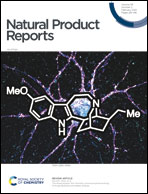The iboga enigma: the chemistry and neuropharmacology of iboga alkaloids and related analogs†
Abstract
Covering: 2000 up to 2020
Few classes of natural products have inspired as many chemists and biologists as have the iboga alkaloids. This family of monoterpenoid indole alkaloids includes the anti-addictive compound ibogaine as well as catharanthine, a precursor to the chemotherapeutic vinblastine. Despite being known for over 120 years, these small molecules continue to challenge our assumptions about biosynthetic pathways, catalyze our creativity for constructing complex architectures, and embolden new approaches for treating mental illness. This review will cover recent advances in both the biosynthesis and chemical synthesis of iboga alkaloids as well as their use as next-generation neurotherapeutics. Whenever appropriate, we provide historical context for the discoveries of the past decade and indicate areas that have yet to be resolved. While significant progress regarding their chemistry and pharmacology has been made since the 1960s, it is clear that the iboga alkaloids will continue to stoke scientific innovation for years to come.



 Please wait while we load your content...
Please wait while we load your content...